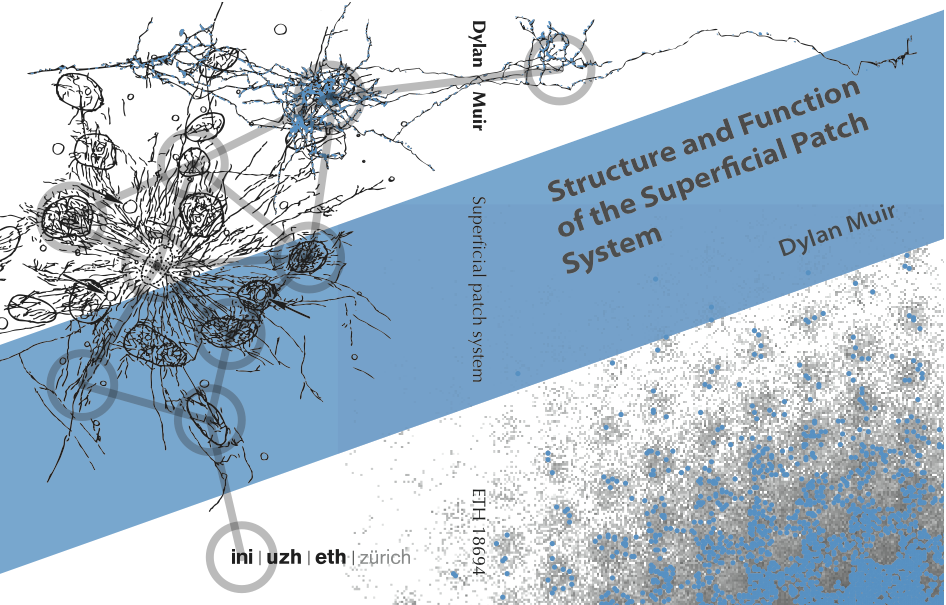Structure and function of the superficial patch system
30th October, 2009
Injections of neural tracers into the superficial layers of cortex reveal a remarkable element of the cortical architecture. Labelled neurons spread their axons widely within a single cortical area — but instead of the uniform diffusion of projections across the cortical surface that one might expect, many thousands of labelled neurons collaborate to form regions of more and less dense innervation.
The result of these injections is to reveal a delicate lattice or grid-like pattern across the surface of neocortex, known as the superficial patch system. That this structure exists for most cortical areas and for many species hints that its function for cortex might be generally applicable to the various tasks undertaken by various cortical areas. Strong evidence implicates excitatory neurons in the superficial layers of cortex as the substrate of the patch system, but the general function and even detailed anatomy of this system remain unknown.
We took several approaches to understand the structure and function of the superficial patch system. By attempting to reproduce the labelling patterns made by injections of tracer into primary visual cortex, we explored how discrete axonal arbors could coalesce to form a network with the properties of the superficial patch system. In these models, individual axonal arbors were formed by geometric rules, relating the spatial locations of terminal axonal clusters with the soma location of the source neuron. We made simulated injections of neural tracers into fields of synthetic axonal arbors, constructed with various combinations of these geometric rules. The simplest assumption, that every neuron follows an identical geometric rule, was shown to be unable to underlie the patch system. However, a model consisting of several geometric rules arranged across the simulated cortical surface reproduced all features of the labelling patterns in primary visual cortex — to our knowledge, our model is the first to do so. Although this model is not directly applicable to other cortical areas, it is consistent with the concept of a like-connects-to-like functional rule within the patch system. We concluded that the patch system cannot be constructed by a rule set that is strictly internal to each neuron, with no influence from its surroundings. Information must be communicated across the surface of cortex by some method, to inform the development of the superficial patch system.
Questioning the implications that patch-like lateral excitatory projections have for the dynamics of cortical circuits lead us to examine the behaviour of simulated sheets of cortical tissue. We observed the intrinsic behaviour of these sheets, under the influence of simulated spontaneous activity. The addition of patterned lateral excitatory connections, similar to those underlying the superficial patch system, lead to interesting and useful dynamics: they enabled the simulated cortical sheets to express spatially-patterned activity. These patterns were not arbitrary: networks selected single phases from a continuous spatial attractor, and expressed these phases in the activity of the network. The form of the continuous attractor was determined by the patterning in the patch-like projections in the network. Similar cortical population dynamics have been observed in vivo, in the anaesthetised cat (Kenet et al. 2003). We found that the mechanism underlying this phenomenon relied on the synchronisation of regions of cortex connected by excitatory connections between patches.
Continuing in our examinations of the structure of the patch system, we compared the spatially-patterned anatomical structure evinced by injections of neural tracers with the spatially-patterned responses of cortex, in the primary visual cortex of the cat and monkey. In contrast to previous comparisons, made in single animals, we proposed a method for extracting the spatial structure of the patch system and of the cortical response that allowed us to pool this data across many animals. We found that the spatial arrangements of labelled patches, and the spatial arrangement of regions activated by oriented grating stimuli were both highly non-random — indeed both systems displayed strong evidence for an arrangement based on a hexagonal grid. Moreover, despite the difference in spatial scale of cat and monkey primary visual cortex, the two species showed an impressive similarity in the arrangement of their patch systems and cortical responses. Finally, the spatial arrangement of labelled patches could not be distinguished from the arrangement of evoked cortical responses, indicating a role for the patch system in the placement of domains across the cortical surface.
We found, through simulation, that the patch system can promote attractor states for cortical activity that match the layout of the underlying patch projections. We also showed that the evoked responses in primary visual cortex to oriented gratings match the layout of the underlying patch projections in that area. Kenet and colleagues showed that during spontaneous activity, population states were expressed by cortex that precisely matched the layout of evoked responses to oriented gratings (Kenet et al. 2003). Taken together, these three points indicate that the superficial patch system plays a strong role in shaping the cortical response. We conclude that the patch projections are the anatomical encoding of cortical states, for which the information represented by each location participating in the state is consistent across the cortical surface. The patch system can push cortical activity towards the pre-encoded representations, to ensure consistency between the cortical response and pre-encoded knowledge of the world.